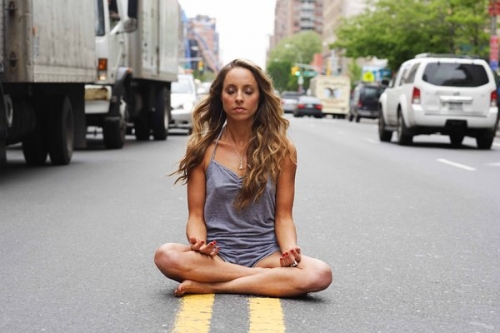Today on Buddha Buzz I must start with the most egregious example of spiritual consumerism I think I have ever seen in my life. As someone who went to journalism school and now makes a living as a magazine editor, I feel like my response to Wednesday’s New York Times article “The New Mantra: Replacing ‘Om’ With ‘Glam’,” should be something more eloquent than what I’m about to share, but really, all I can summon up to say about this article is…
“Noooooooooooooooooooooooooooooooooooo!” followed by loud sobbing.

Let me explain. The piece is based around the question “What should you wear while you meditate?” Okay—valid question, especially for beginners. But the answer shouldn’t go beyond “Something comfortable that won’t add unnecessary distraction.” Instead, the New York Times has created an article that is essentially an advertisement for overly expensive clothing manufactured by companies who are trying to capitalize on the overly affluent who meditate now that it’s trendy and cool to do so. You can read (and then bemoan) the full article here or read my handpicked excerpts below.
For a new generation of “spiritual seekers,” a daily meditation practice has become the emotional equivalent of green juice: a well-being essential. Russell Brand has described it as “like a shower for your brain,” while the Victoria’s Secret model Miranda Kerr has said it helps her stay in goddesslike shape, inside and out. And when “transcendental” and “trendy” appear in the same sentence, one question inevitably comes to mind (no matter how hard you are trying to empty the contents of your cranium): What to wear?
The athletic-wear company Lululemon, known for its yoga togs, introduced a meditation-specific capsule collection in fall 2012, with pieces retailing at relatively affordable prices, including a Devotion Long-Sleeve Tee ($68) and an Intuition Sweater Wrap ($178) that doubles as a meditation blanket. With its extra-deep hood, the Please Me Pullover ($118) is perfect to wear during Zen Buddhist meditation practice, said Amanda Casgar, a spokeswoman for the company, since during the process “you keep your eyes open but focus on a point on the floor in front of you.”
For the more affluent enthusiast, Donna Karan’s Urban Zen line, affiliated with her charitable wellness foundation of the same name, has become a popular choice (sweat pants, $995).
Quick aside: since when has an almost $200 sweater become classified as “relatively affordable”? Anyway. From later in the article:
But the self-help author Gabrielle Bernstein, whose new book, “May Cause Miracles: A 40-Day Guidebook of Subtle Shifts for Radical Change and Unlimited Happiness,” was published this month, sees no conflict in glamming up for meditation.
“If you want to get more excited about your practice,” she said, “choose an outfit you want to put on.”
Ms. Bernstein described her premeditation ritual: “I shower and put almond oil on my body before I meditate—and then I put on an outfit,” she said. “I don’t want to go straight from my bed to my meditation pillow, the same way you wouldn’t wear your street clothes in bed.”
And yet her choices tend to be simple—often white (“to make me feel more awake and vibrant”), with something to cover her head (“to contain the power energy I’m creating”) and always a cozy pair of socks. She also wears her hair down and avoids belts or drawstring pants, since “tying anything to your body blocks the energy flow,” she said.
Look, guys. I’ve meditated in yoga pants. I’ve meditated in sweatpants. In a pinch, I’ve meditated in skinny jeans and skirts. If you’re obsessing about what you’re wearing while meditating, you’re missing the point. Shame on you, New York Times, for printing such ridiculousness.
This week I found the blog of entrepreneur Jia Jiang, who is embarking upon what he calls “100 Days of Rejection Therapy.” He makes one crazy request per day—challenging a random CEO to a staring contest, asking a PetSmart employee to trim his hair, making the safety announcement on a flight—with the hope that he’ll be rejected, therefore overcoming his fears and becoming a more savvy entrepreneur who is willing to take risks. He films all of his interactions and blogs about them here. Strictly Buddhist it is not, but it’s such a fun and helpful idea that I thought I’d share. Here he is asking a fireman if he can slide down the firehouse’s pole. Enjoy!
P.S. Do you identify as spiritual but not religious? Turns out you’re more likely to develop a mental disorder or be dependent on drugs than those who follow an organized religion, says a new study in the British Journal of Psychiatry. Check out CNN’s coverage of it here.
Thank you for subscribing to Tricycle! As a nonprofit, we depend on readers like you to keep Buddhist teachings and practices widely available.